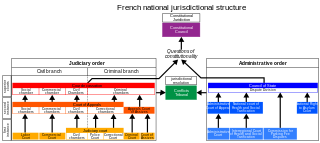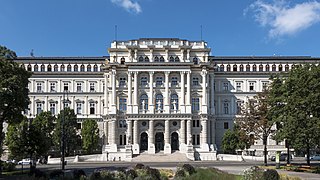
The Constitutional Council is the highest constitutional authority in France. It was established by the Constitution of the Fifth Republic on 4 October 1958 to ensure that constitutional principles and rules are upheld. It is housed in the Palais-Royal, Paris. Its main activity is to rule on whether proposed statutes conform with the Constitution, after they have been voted by Parliament and before they are signed into law by the President of the Republic, or passed by the government as a decree, which has law status in many domains, a right granted to the government under delegation of Parliament.

The Constitution of Austria is the body of all constitutional law of the Republic of Austria on the federal level. It is split up over many different acts. Its centerpiece is the Federal Constitutional Law (Bundes-Verfassungsgesetz) (B-VG), which includes the most important federal constitutional provisions.
Judicial restraint is a judicial interpretation that recommends favoring the status quo in judicial activities and is the opposite of judicial activism. Aspects of judicial restraint include the principle of stare decisis ; a conservative approach to standing and a reluctance to grant certiorari; and a tendency to deliver narrowly tailored verdicts, avoiding "unnecessary resolution of broad questions."
In law, the standard of review is the amount of deference given by one court in reviewing a decision of a lower court or tribunal. A low standard of review means that the decision under review will be varied or overturned if the reviewing court considers there is any error at all in the lower court's decision. A high standard of review means that deference is accorded to the decision under review, so that it will not be disturbed just because the reviewing court might have decided the matter differently; it will be varied only if the higher court considers the decision to have obvious error. The standard of review may be set by statute or precedent. In the United States, "standard of review" also has a separate meaning concerning the level of deference the judiciary gives to Congress when ruling on the constitutionality of legislation.

French law has a dual jurisdictional system comprising private law, also known as judicial law, and public law.

In most legal jurisdictions, a supreme court, also known as a court of last resort, apex court, and highcourt of appeal, is the highest court within the hierarchy of courts. Broadly speaking, the decisions of a supreme court are not subject to further review by any other court. Supreme courts typically function primarily as appellate courts, hearing appeals from decisions of lower trial courts, or from intermediate-level appellate courts.

The judiciary of Austria is the system of courts, prosecution and correction of the Republic of Austria as well as the branch of government responsible for upholding the rule of law and administering justice. The judiciary is independent of the other two branches of government and is committed to guaranteeing fair trials and equality before the law. It has broad and effective powers of judicial review.

The Constitutional Court in Austria is the tribunal responsible for judicial review.

Judicial review is a process under which executive, legislative and administrative actions are subject to review by the judiciary. A court with authority for judicial review may invalidate laws, acts and governmental actions that are incompatible with a higher authority: an executive decision may be invalidated for being unlawful or a statute may be invalidated for violating the terms of a constitution. Judicial review is one of the checks and balances in the separation of powers: the power of the judiciary to supervise the legislative and executive branches when the latter exceed their authority. The doctrine varies between jurisdictions, so the procedure and scope of judicial review may differ between and within countries.
The law of Virginia consists of several levels of legal rules, including constitutional, statutory, regulatory, case law, and local laws. The Code of Virginia contains the codified legislation that define the general statutory laws for the Commonwealth.
The law of Illinois consists of several levels, including constitutional, statutory, and regulatory law, as well as case law and local law. The Illinois Compiled Statutes (ILCS) form the general statutory law.
The law of the U.S. state of Georgia consists of several levels, including constitutional, statutory, and regulatory law, as well as case law and local law. The Official Code of Georgia Annotated forms the general statutory law.
The law of Michigan consists of several levels, including constitutional, statutory, regulatory and case law. The Michigan Compiled Laws form the general statutory law.
The law of North Carolina consists of several levels, including constitutional, statutory, regulatory, case law, and local law.
The law of Washington consists of several levels, including constitutional, statutory, regulatory and case law, as well as local ordinances. The Revised Code of Washington forms the general statutory law.

The Supreme Court of Justice is the final court of appeal of Austria in civil and criminal matters. Along with the Supreme Administrative Court and the Constitutional Court, it is one of Austria's three apex courts.

In the Republic of Austria, the Supreme Administrative Court is the appellate court to which appeals may be made from the decisions of the country's eleven administrative trial courts. The Supreme Administrative Court also resolves demarcation disputes within the administrative court system and hears complaints about administrative trial courts that fail to issue verdicts legally required of them in a timely manner.
Theodor "Theo" Öhlinger is an Austrian constitutional scholar and educator. Öhlinger was a member the Austrian Constitutional Court from 1977 to 1989 and a professor of constitutional and administrative law at the University of Vienna from 1974 to 2007. Since 1999, he has been serving as the deputy chairman of the board of trustees of the Vienna Museum of Art History. Öhlinger has published 23 books and more than 350 scholarly articles and appears as a frequent commentator on legal issues in the Austrian news media. Austrian President Alexander van der Bellen called him Austria's "operating system" during the turbulent times of May 2019.

In Austria, a minister is a member of the Cabinet that usually leads a ministry or a division of the Chancellery.

In Austrian constitutional law, a supreme executive organ , is an elected official, political appointee, or collegiate body with ultimate responsibility for a certain class of administrative decisions – either decisions in some specific area of public administration or decisions of some specific type. The president, for example, is the supreme executive organ with regards to appointing judges; the minister of justice is the supreme executive organ with regards to running the prosecution service; the president of the Constitutional Court is the supreme executive organ with regards to the operational management of the Constitutional Court. The Constitutional Court itself, on the other hand, is not a supreme organ because its decisions, while definitive, are judicial and not administrative in nature.














